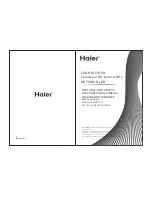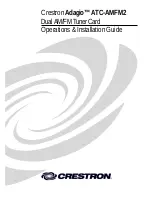
Service Modes, Error Codes, and Fault Finding
EN 27
EL1.1U
5.
5.5
Error Codes
5.5.1
Introduction
The error code buffer contains all detected errors since the last
time the buffer was erased. The buffer is written from left to
right, new errors are logged at the left side, and all other errors
shift one position to the right.
When an error has occurred, the error is added to the list of
errors, provided the list is not full or the error is a protection
error.
When an error occurs and the error buffer is full, then the new
error is not added, and the error buffer stays intact (history is
maintained), except when the error is a protection error.
To prevent that an occasional error stays in the list forever, the
error is removed from the list after 50+ operation hours.
When multiple errors occur (errors occurred within a short time
span), there is a high probability that there is some relation
between them.
Basically there are three kinds of errors:
•
Errors detected by the Stand-by Processor.
These
errors will always lead to protection and an automatic start
of the blinking LED for the concerned error (see paragraph
“The Blinking LED Procedure”). In these cases SDM can
be used to start up (see chapter “Stepwise Start-up”).
•
Errors detected by VIPER that lead to protection.
In this
case the TV will go to protection and the front LED will blink
at 3 Hz. Further diagnosis via service modes is not possible
here (see also paragraph “Error Codes” -> “Error Buffer” -
> “Extra Info”).
•
Errors detected by VIPER that do not lead to
protection.
In this case the error can be read out via
ComPair, via blinking LED method, or in case you have
picture, via SAM.
5.5.2
How to Read the Error Buffer
Use one of the following methods:
•
On screen via the SAM (only if you have a picture). E.g.:
–
00 00 00 00 00
: No errors detected
–
06 00 00 00 00
: Error code 6 is the last and only
detected error
–
09 06 00 00 00
: Error code 6 was first detected and
error code 9 is the last detected error
•
Via the blinking LED procedure (when you have no
picture). See next paragraph.
•
Via ComPair.
5.5.3
How to Clear the Error Buffer
Use one of the following methods:
•
By activation of the “RESET ERROR BUFFER” command
in the SAM menu.
•
With a normal RC, key in sequence “MUTE” followed by
“062599” and “OK”.
•
If the content of the error buffer has not changed for 50+
hours, it resets automatically.
5.5.4
Error Buffer
In case of non-intermittent faults, clear the error buffer before
you begin the repair (
before
clearing the buffer, write down the
content, as this history can give you significant information).
This to ensure that old error codes are no longer present.
If possible, check the entire contents of the error buffer. In
some situations, an error code is only the result of another error
code and not the actual cause (e.g., a fault in the protection
detection circuitry can also lead to a protection).
There are several mechanisms of error detection:
•
Via error bits in the status registers of ICs.
•
Via polling on I/O pins going to the stand-by processor.
•
Via sensing of analogue values on the stand-by processor.
•
Via a “not acknowledge” of an I
2
C communication
Take notice that some errors need more than 90 seconds
before they start blinking. So in case of problems wait 2
minutes from start-up onwards, and then check if the front LED
is blinking.
Table 5-3 Error code overview
Extra Info
•
Error 1 (I
2
C bus 1 blocked).
When this error occurs, the
TV will go to protection and the front LED will blink at 3 Hz.
Now you can partially restart the TV via the SDM shortcut
pins on the SSB. Depending on the software version it is
possible that no further diagnose (error code read-out) is
possible. With the knowledge that only errors 1, 2, 4, and
63 result in a 3 Hz blinking LED, the range of possible
defects is limited.
•
Error 2 (I
2
C bus 2 blocked).
When this error occurs, the
TV will go to protection and the front LED will blink at 3 Hz.
Now you can partially restart the TV via the SDM shortcut
Error
Description
Error/Prot
Detected by Device
Defective
module
Result
1
I
2
C1
P
VIPER
n.a.
I
2
C1_blocked
Prot 3 Hz blinking
2
I
2
C2
P
VIPER
n.a.
I
2
C2_blocked
Prot 3 Hz blinking
3
I
2
C3
P
Stby µP
n.a.
I
2
C3_blocked
Prot 3 Hz blinking
4
I
2
C4
P
VIPER
n.a.
I
2
C4_blocked
Prot 3 Hz blinking
5
VIPER does not boot (hardware failure)
P
Stby µP
PNX8550
Prot Error blinking
6
5V supply
P
Stby µP
n.a.
Prot Error blinking
8
1.2V DC/DC
P
Stby µP
n.a.
Prot Error blinking
11
3.3V DC/DC
P
Stby µP
n.a.
Prot Error blinking
12
12V supply
P
Stby µP
n.a.
Prot Error blinking
14
Supply Class D amplifiers
P
Stby µP
Prot Error blinking
17
MPIF1 Audio Supply (ASUP)
E
VIPER
PNX3000
IF I/O
Error logged
18
MPIF1 ref freq
E
VIPER
PNX3000
IF I/O
Error logged
25
Supply fault
P
Stby µP
Prot Error blinking
27
Phoenix
E
VIPER
PNX2015B
HD subsystem
Error logged
29
AVIP1
E
VIPER
PNX2015
AV input processor 1
Error logged
32
MPIF1
E
VIPER
KN10241C
Analog Front End 1
Error logged
34
Tuner1
E
VIPER
Tuner 1
Error logged
37
Channel decoder
E
VIPER
NXT2003
Error logged
43
Hi Rate Front End
E
VIPER
TDA8751
HDMI
Error logged
45
Columbus 1
E
VIPER
PNX2015
Comb filter
Error logged
53
VIPER does not boot (software failure)
P
Stby µP
PNX8550
Prot Error blinking
63
PDP Display
P
VIPER
Display
Prot 3 Hz blinking
Содержание EL1.1U
Страница 32: ...Service Modes Error Codes and Fault Finding EN 32 EL1 1U 5 Personal Notes E_06532_012 eps 131004 ...
Страница 101: ...Circuit Diagrams and PWB Layouts EN 101 EL1 1U AA 7 Layout SSB Top Side Part 1 Part 1 G_16290_050a eps 270106 ...
Страница 102: ...EN 102 EL1 1U AA 7 Circuit Diagrams and PWB Layouts Layout SSB Top Side Part 2 Part 2 G_16290_050b eps 270106 ...
Страница 104: ...EN 104 EL1 1U AA 7 Circuit Diagrams and PWB Layouts Layout SSB Bottom Side Part 1 Part 1 G_16290_051a eps 270106 ...
Страница 105: ...Circuit Diagrams and PWB Layouts EN 105 EL1 1U AA 7 Layout SSB Bottom Side Part 2 Part 2 G_16290_051b eps 270106 ...
















































